New Product Launch Strategy: Competitive Marketing Analysis Report
VerifiedAdded on 2023/02/01
|7
|1222
|53
Report
AI Summary
This report provides a comprehensive analysis of a new product launch strategy, focusing on competitive marketing strategies, STP (Segmentation, Targeting, Positioning) analysis, and marketing program implementation. The introduction highlights the importance of innovation in achieving a competitive advantage within the consumer market. The discussion section elaborates on Michael Porter's competitive strategy framework, emphasizing the use of social-network websites and digital marketing platforms to reach consumers. The STP section details market segmentation based on demographic factors, targeting strategies, and market positioning to build brand equity. The marketing program outlines strategic steps for a successful product launch, including product evaluation, market analysis, competitor analysis, and promotional activities. The report also suggests using local media channels, training media spokespersons, and developing content marketing materials to support the product launch. References to academic sources support the strategies discussed.

Running Head: NEW PRODUCT LAUNCH STRATEGY
New product launch strategy
Name of the Student
Name of the University
Author’s Note
New product launch strategy
Name of the Student
Name of the University
Author’s Note
Paraphrase This Document
Need a fresh take? Get an instant paraphrase of this document with our AI Paraphraser
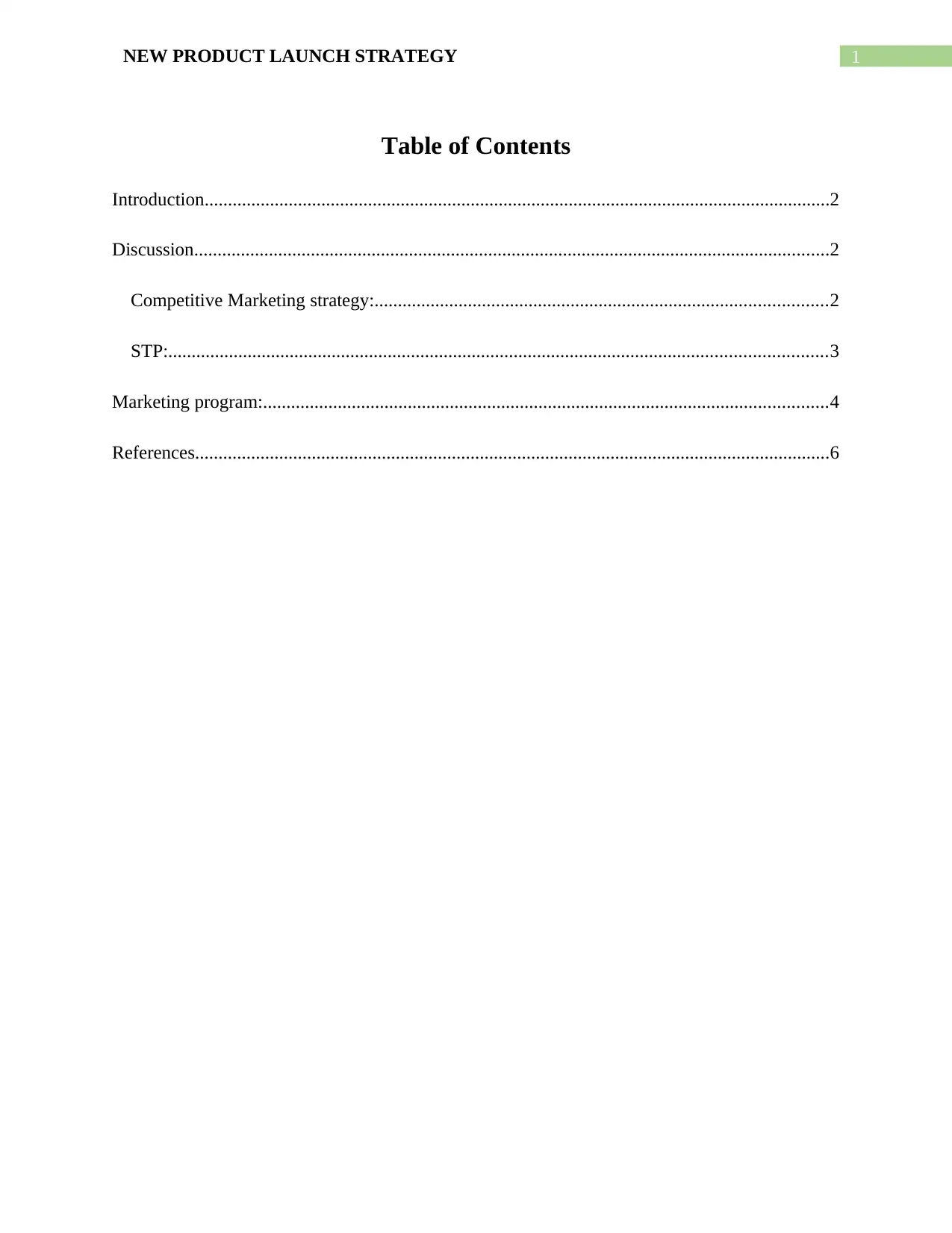
1NEW PRODUCT LAUNCH STRATEGY
Table of Contents
Introduction......................................................................................................................................2
Discussion........................................................................................................................................2
Competitive Marketing strategy:.................................................................................................2
STP:.............................................................................................................................................3
Marketing program:.........................................................................................................................4
References........................................................................................................................................6
Table of Contents
Introduction......................................................................................................................................2
Discussion........................................................................................................................................2
Competitive Marketing strategy:.................................................................................................2
STP:.............................................................................................................................................3
Marketing program:.........................................................................................................................4
References........................................................................................................................................6
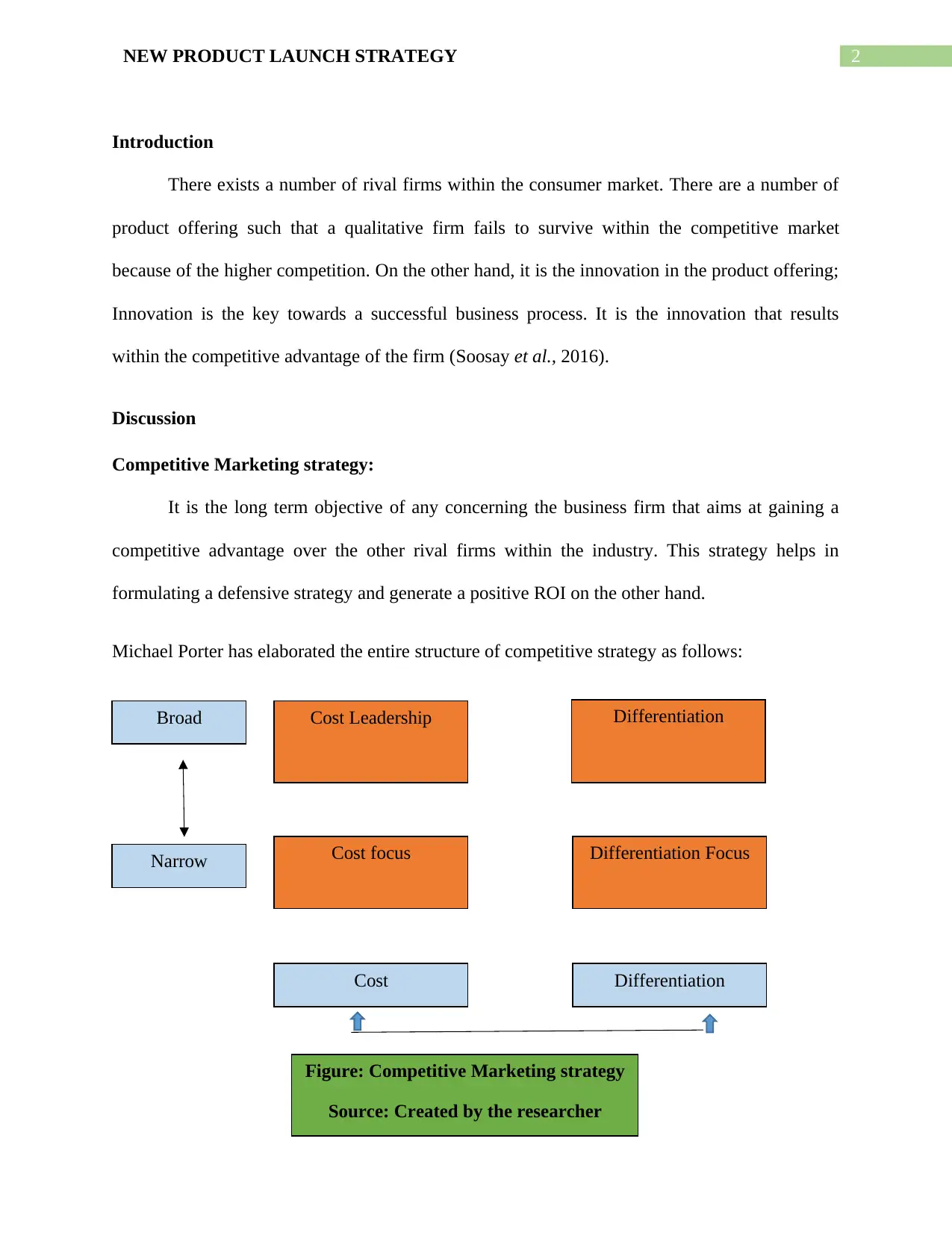
2NEW PRODUCT LAUNCH STRATEGY
Introduction
There exists a number of rival firms within the consumer market. There are a number of
product offering such that a qualitative firm fails to survive within the competitive market
because of the higher competition. On the other hand, it is the innovation in the product offering;
Innovation is the key towards a successful business process. It is the innovation that results
within the competitive advantage of the firm (Soosay et al., 2016).
Discussion
Competitive Marketing strategy:
It is the long term objective of any concerning the business firm that aims at gaining a
competitive advantage over the other rival firms within the industry. This strategy helps in
formulating a defensive strategy and generate a positive ROI on the other hand.
Michael Porter has elaborated the entire structure of competitive strategy as follows:
Cost Leadership Differentiation
Differentiation FocusCost focus
Cost Differentiation
Broad
Narrow
Figure: Competitive Marketing strategy
Source: Created by the researcher
Introduction
There exists a number of rival firms within the consumer market. There are a number of
product offering such that a qualitative firm fails to survive within the competitive market
because of the higher competition. On the other hand, it is the innovation in the product offering;
Innovation is the key towards a successful business process. It is the innovation that results
within the competitive advantage of the firm (Soosay et al., 2016).
Discussion
Competitive Marketing strategy:
It is the long term objective of any concerning the business firm that aims at gaining a
competitive advantage over the other rival firms within the industry. This strategy helps in
formulating a defensive strategy and generate a positive ROI on the other hand.
Michael Porter has elaborated the entire structure of competitive strategy as follows:
Cost Leadership Differentiation
Differentiation FocusCost focus
Cost Differentiation
Broad
Narrow
Figure: Competitive Marketing strategy
Source: Created by the researcher
⊘ This is a preview!⊘
Do you want full access?
Subscribe today to unlock all pages.

Trusted by 1+ million students worldwide
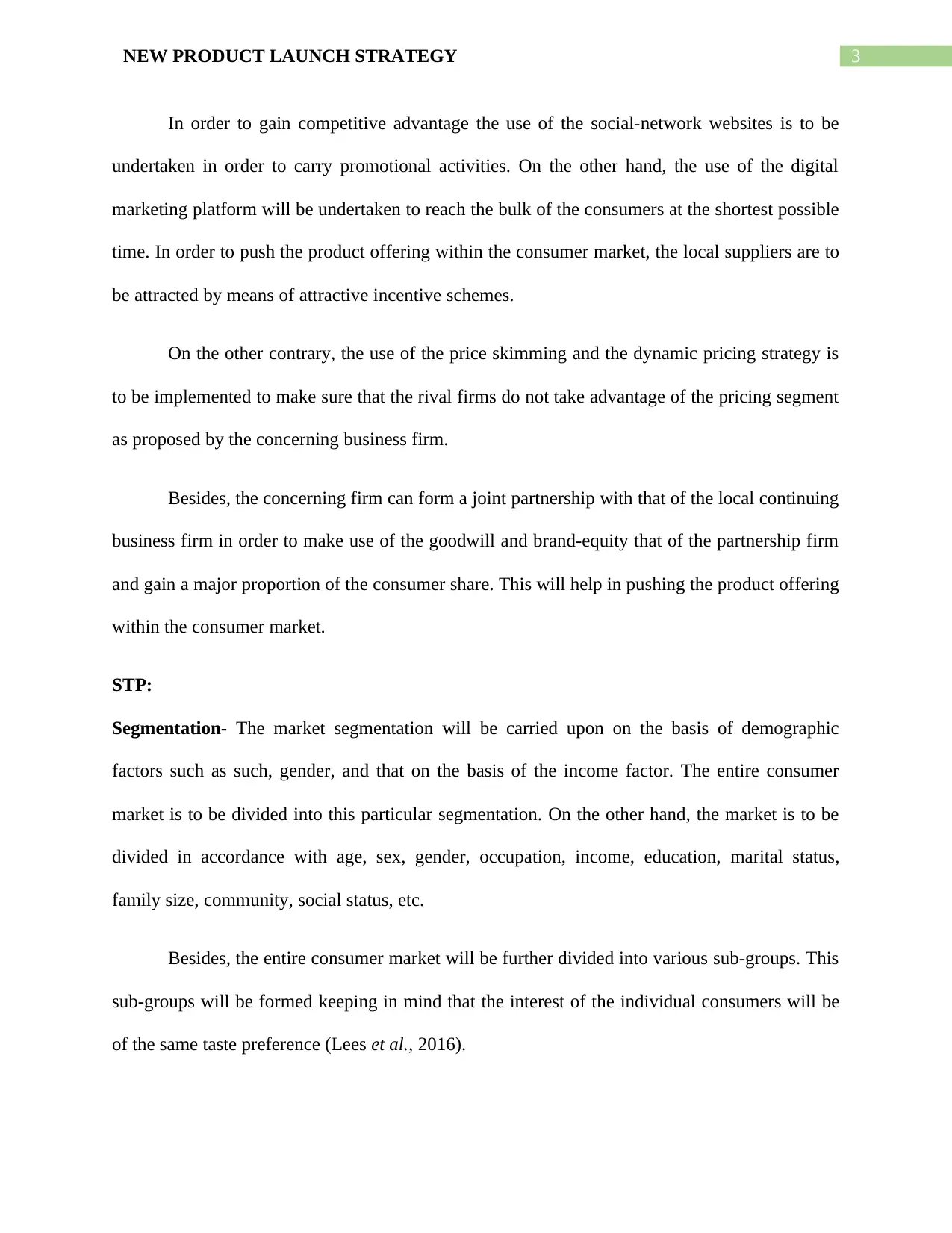
3NEW PRODUCT LAUNCH STRATEGY
In order to gain competitive advantage the use of the social-network websites is to be
undertaken in order to carry promotional activities. On the other hand, the use of the digital
marketing platform will be undertaken to reach the bulk of the consumers at the shortest possible
time. In order to push the product offering within the consumer market, the local suppliers are to
be attracted by means of attractive incentive schemes.
On the other contrary, the use of the price skimming and the dynamic pricing strategy is
to be implemented to make sure that the rival firms do not take advantage of the pricing segment
as proposed by the concerning business firm.
Besides, the concerning firm can form a joint partnership with that of the local continuing
business firm in order to make use of the goodwill and brand-equity that of the partnership firm
and gain a major proportion of the consumer share. This will help in pushing the product offering
within the consumer market.
STP:
Segmentation- The market segmentation will be carried upon on the basis of demographic
factors such as such, gender, and that on the basis of the income factor. The entire consumer
market is to be divided into this particular segmentation. On the other hand, the market is to be
divided in accordance with age, sex, gender, occupation, income, education, marital status,
family size, community, social status, etc.
Besides, the entire consumer market will be further divided into various sub-groups. This
sub-groups will be formed keeping in mind that the interest of the individual consumers will be
of the same taste preference (Lees et al., 2016).
In order to gain competitive advantage the use of the social-network websites is to be
undertaken in order to carry promotional activities. On the other hand, the use of the digital
marketing platform will be undertaken to reach the bulk of the consumers at the shortest possible
time. In order to push the product offering within the consumer market, the local suppliers are to
be attracted by means of attractive incentive schemes.
On the other contrary, the use of the price skimming and the dynamic pricing strategy is
to be implemented to make sure that the rival firms do not take advantage of the pricing segment
as proposed by the concerning business firm.
Besides, the concerning firm can form a joint partnership with that of the local continuing
business firm in order to make use of the goodwill and brand-equity that of the partnership firm
and gain a major proportion of the consumer share. This will help in pushing the product offering
within the consumer market.
STP:
Segmentation- The market segmentation will be carried upon on the basis of demographic
factors such as such, gender, and that on the basis of the income factor. The entire consumer
market is to be divided into this particular segmentation. On the other hand, the market is to be
divided in accordance with age, sex, gender, occupation, income, education, marital status,
family size, community, social status, etc.
Besides, the entire consumer market will be further divided into various sub-groups. This
sub-groups will be formed keeping in mind that the interest of the individual consumers will be
of the same taste preference (Lees et al., 2016).
Paraphrase This Document
Need a fresh take? Get an instant paraphrase of this document with our AI Paraphraser
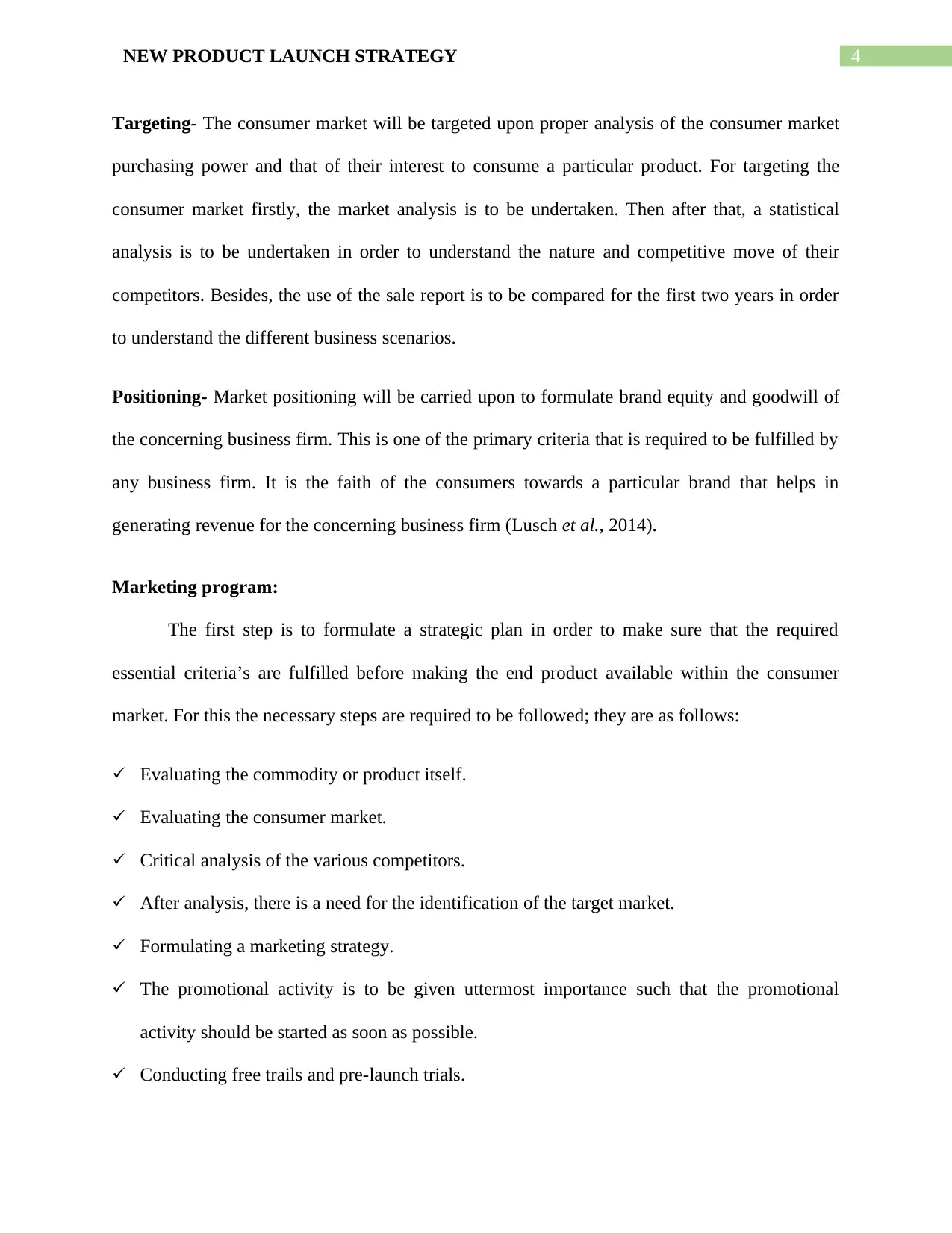
4NEW PRODUCT LAUNCH STRATEGY
Targeting- The consumer market will be targeted upon proper analysis of the consumer market
purchasing power and that of their interest to consume a particular product. For targeting the
consumer market firstly, the market analysis is to be undertaken. Then after that, a statistical
analysis is to be undertaken in order to understand the nature and competitive move of their
competitors. Besides, the use of the sale report is to be compared for the first two years in order
to understand the different business scenarios.
Positioning- Market positioning will be carried upon to formulate brand equity and goodwill of
the concerning business firm. This is one of the primary criteria that is required to be fulfilled by
any business firm. It is the faith of the consumers towards a particular brand that helps in
generating revenue for the concerning business firm (Lusch et al., 2014).
Marketing program:
The first step is to formulate a strategic plan in order to make sure that the required
essential criteria’s are fulfilled before making the end product available within the consumer
market. For this the necessary steps are required to be followed; they are as follows:
Evaluating the commodity or product itself.
Evaluating the consumer market.
Critical analysis of the various competitors.
After analysis, there is a need for the identification of the target market.
Formulating a marketing strategy.
The promotional activity is to be given uttermost importance such that the promotional
activity should be started as soon as possible.
Conducting free trails and pre-launch trials.
Targeting- The consumer market will be targeted upon proper analysis of the consumer market
purchasing power and that of their interest to consume a particular product. For targeting the
consumer market firstly, the market analysis is to be undertaken. Then after that, a statistical
analysis is to be undertaken in order to understand the nature and competitive move of their
competitors. Besides, the use of the sale report is to be compared for the first two years in order
to understand the different business scenarios.
Positioning- Market positioning will be carried upon to formulate brand equity and goodwill of
the concerning business firm. This is one of the primary criteria that is required to be fulfilled by
any business firm. It is the faith of the consumers towards a particular brand that helps in
generating revenue for the concerning business firm (Lusch et al., 2014).
Marketing program:
The first step is to formulate a strategic plan in order to make sure that the required
essential criteria’s are fulfilled before making the end product available within the consumer
market. For this the necessary steps are required to be followed; they are as follows:
Evaluating the commodity or product itself.
Evaluating the consumer market.
Critical analysis of the various competitors.
After analysis, there is a need for the identification of the target market.
Formulating a marketing strategy.
The promotional activity is to be given uttermost importance such that the promotional
activity should be started as soon as possible.
Conducting free trails and pre-launch trials.
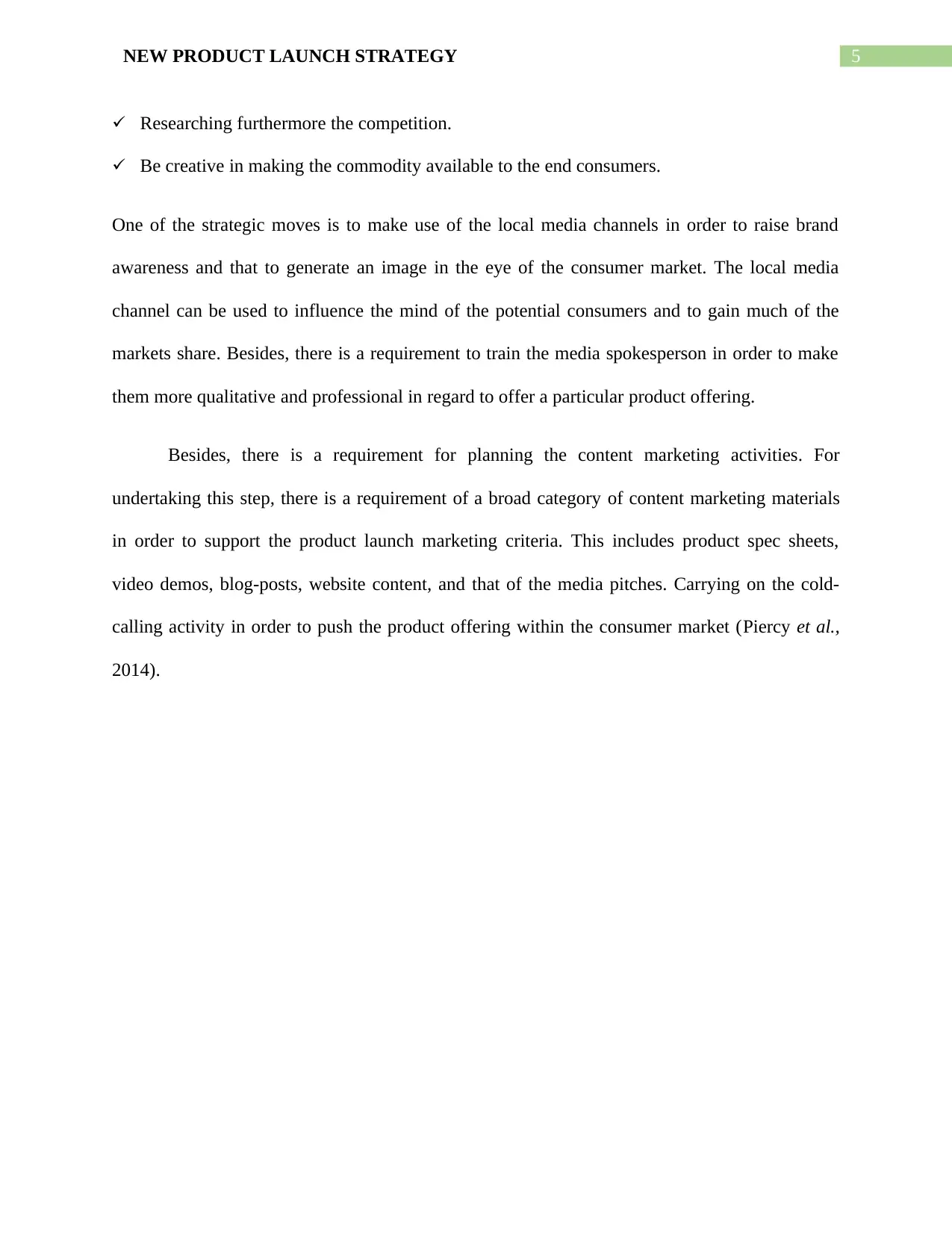
5NEW PRODUCT LAUNCH STRATEGY
Researching furthermore the competition.
Be creative in making the commodity available to the end consumers.
One of the strategic moves is to make use of the local media channels in order to raise brand
awareness and that to generate an image in the eye of the consumer market. The local media
channel can be used to influence the mind of the potential consumers and to gain much of the
markets share. Besides, there is a requirement to train the media spokesperson in order to make
them more qualitative and professional in regard to offer a particular product offering.
Besides, there is a requirement for planning the content marketing activities. For
undertaking this step, there is a requirement of a broad category of content marketing materials
in order to support the product launch marketing criteria. This includes product spec sheets,
video demos, blog-posts, website content, and that of the media pitches. Carrying on the cold-
calling activity in order to push the product offering within the consumer market (Piercy et al.,
2014).
Researching furthermore the competition.
Be creative in making the commodity available to the end consumers.
One of the strategic moves is to make use of the local media channels in order to raise brand
awareness and that to generate an image in the eye of the consumer market. The local media
channel can be used to influence the mind of the potential consumers and to gain much of the
markets share. Besides, there is a requirement to train the media spokesperson in order to make
them more qualitative and professional in regard to offer a particular product offering.
Besides, there is a requirement for planning the content marketing activities. For
undertaking this step, there is a requirement of a broad category of content marketing materials
in order to support the product launch marketing criteria. This includes product spec sheets,
video demos, blog-posts, website content, and that of the media pitches. Carrying on the cold-
calling activity in order to push the product offering within the consumer market (Piercy et al.,
2014).
⊘ This is a preview!⊘
Do you want full access?
Subscribe today to unlock all pages.

Trusted by 1+ million students worldwide
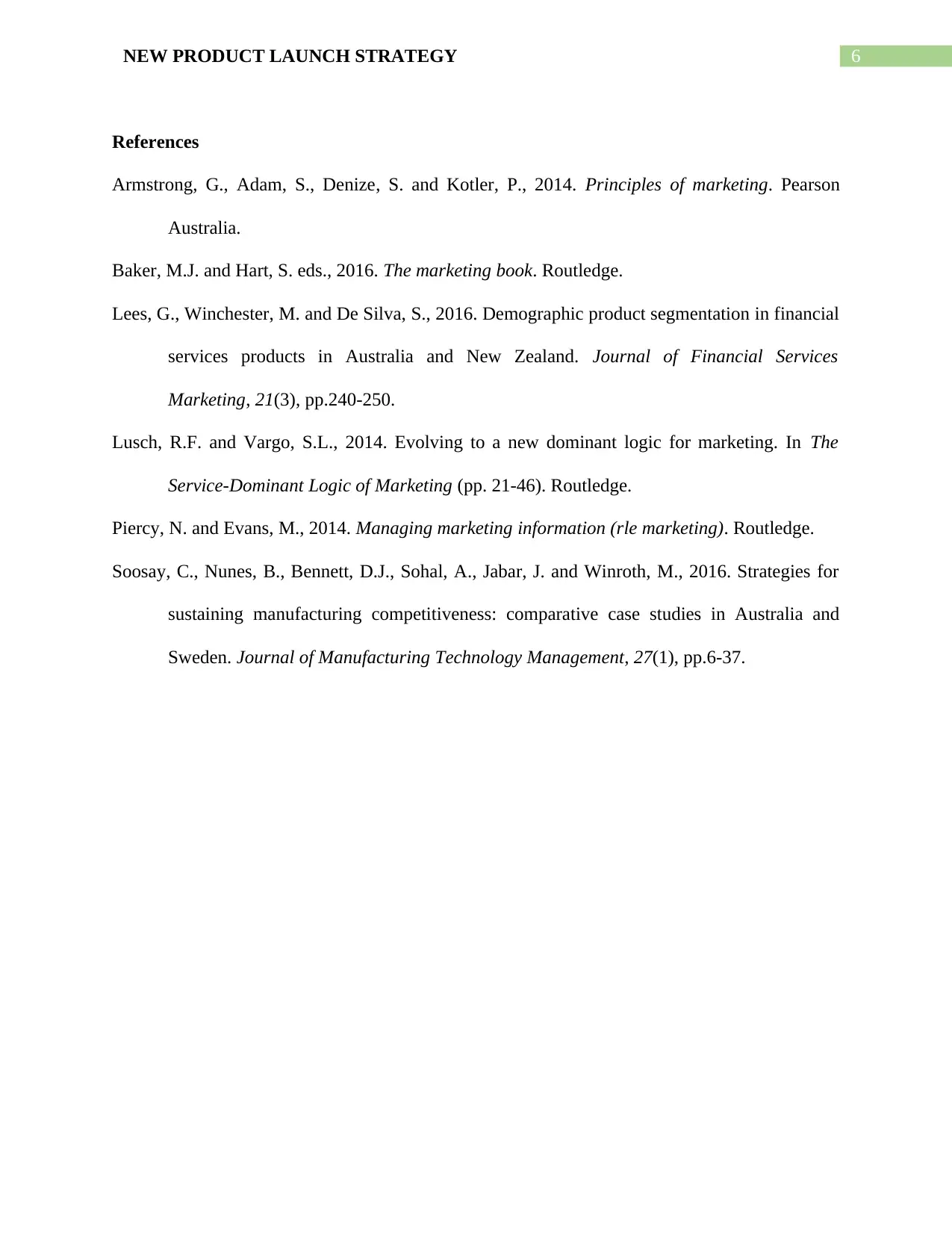
6NEW PRODUCT LAUNCH STRATEGY
References
Armstrong, G., Adam, S., Denize, S. and Kotler, P., 2014. Principles of marketing. Pearson
Australia.
Baker, M.J. and Hart, S. eds., 2016. The marketing book. Routledge.
Lees, G., Winchester, M. and De Silva, S., 2016. Demographic product segmentation in financial
services products in Australia and New Zealand. Journal of Financial Services
Marketing, 21(3), pp.240-250.
Lusch, R.F. and Vargo, S.L., 2014. Evolving to a new dominant logic for marketing. In The
Service-Dominant Logic of Marketing (pp. 21-46). Routledge.
Piercy, N. and Evans, M., 2014. Managing marketing information (rle marketing). Routledge.
Soosay, C., Nunes, B., Bennett, D.J., Sohal, A., Jabar, J. and Winroth, M., 2016. Strategies for
sustaining manufacturing competitiveness: comparative case studies in Australia and
Sweden. Journal of Manufacturing Technology Management, 27(1), pp.6-37.
References
Armstrong, G., Adam, S., Denize, S. and Kotler, P., 2014. Principles of marketing. Pearson
Australia.
Baker, M.J. and Hart, S. eds., 2016. The marketing book. Routledge.
Lees, G., Winchester, M. and De Silva, S., 2016. Demographic product segmentation in financial
services products in Australia and New Zealand. Journal of Financial Services
Marketing, 21(3), pp.240-250.
Lusch, R.F. and Vargo, S.L., 2014. Evolving to a new dominant logic for marketing. In The
Service-Dominant Logic of Marketing (pp. 21-46). Routledge.
Piercy, N. and Evans, M., 2014. Managing marketing information (rle marketing). Routledge.
Soosay, C., Nunes, B., Bennett, D.J., Sohal, A., Jabar, J. and Winroth, M., 2016. Strategies for
sustaining manufacturing competitiveness: comparative case studies in Australia and
Sweden. Journal of Manufacturing Technology Management, 27(1), pp.6-37.
1 out of 7
Related Documents
Your All-in-One AI-Powered Toolkit for Academic Success.
+13062052269
info@desklib.com
Available 24*7 on WhatsApp / Email
![[object Object]](/_next/static/media/star-bottom.7253800d.svg)
Unlock your academic potential
Copyright © 2020–2025 A2Z Services. All Rights Reserved. Developed and managed by ZUCOL.





